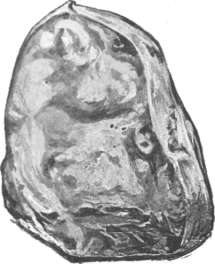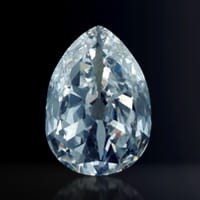
June 30, 1893, appeared to be just another day at the Jagersfontein Mine in South Africa until a worker, performing the mundane task of shoveling dirt into a truck, made the startling discovery of a rough, magnificent-looking diamond. Fearing that reporting his find to his ethically challenged overseer could cost him credit for the discovery, the worker wisely took the stone directly to the mine manager, thus ensuring himself credit for the discovery and the handsome reward that went with it. In this case, that reward consisted of a horse, bridle, and saddle.
Weighing in at a whopping 995.2 carats, blue-white in color and of fine quality, this magnificent gem claimed the status of largest diamond known in the world, surpassing all of the historic diamond discoveries in India, a record that country had proudly held for five centuries. Because of its “loaf of bread or mountain” shape, flat on the bottom rising to a peak, the impressive gem was named Excelsior which means “ever higher”.
By 1903, the Excelsior had made its way to London. With its intimidating size no doubt scaring off potential buyers, the crystal was finally sent off to Asscher of Amsterdam for cutting. Upon closer examination of the diamond, Asscher discovered the disappointing fact that the Excelsior diamond contained a number of small dark inclusions. These inclusions made any hope of cutting a record-setting gem impossible and created a real challenge for Asscher. After a thorough study was conducted, Asscher decided to cleave the massive diamond into ten pieces, resulting in the largest stone from the cut (labeled the Excelsior I) weighing only 69.68 carats. The remainder of the Excelsior was cut into a total of twenty large polished gems – with ten of them over 10 carats – ranging from approximately 47 carats to less than 1 carat. Of the original 995.2 carats, 373.75 carats of gem quality material was created. Considering the obstacles presented by the nature of the Excelsior diamond in its rough form, the results of the cutting were beyond all expectations, a real tribute to the Royal Asscher Diamond Company’s craftsmanship. Below is a list of the largest cuts of the Excelsior in order of size.
Excelsior Diamonds
| Name | Cut | Weight | |
|---|---|---|---|
| 1 | Excelsior I | Pear-Shape | 69.68 carats |
| 2 | Excelsior II | Pear-Shape | 47.03 carats |
| 3 | Excelsior III | Pear-Shape | 46.90 carats |
| 4 | Excelsior IV | Marquise-Cut | 40.23 carats |
| 5 | Excelsior V | Pear-Shape | 34.91 carats |
| 6 | Excelsior VI | Pear-Shape | 28.61 carats |
| 7 | Excelsior VII | Marquise-Cut | 26.30 carats |
| 8 | Excelsior VIII | Pear-Shape | 24.31 carats |
| 9 | Excelsior IX | Pear-Shape | 16.78 carats |
| 10 | Excelsior X | Pear-Shape | 13.86 carats |
| 11 | Excelsior XI | Pear-Shape | 9.82 carats |

Photo Courtesy of Mouawad.com.
Each of these gems was sold separately. Tiffany & Co. in New York purchased three stones in 1939. Other buyers preferred to keep their identities secret, creating a mystery as to the fate of the remaining Excelsior diamonds. It is known that De Beers displayed one of the marquise-shaped stones at the 1939 World’s Fair in New York. In 1984 Graff Diamonds Limited of London announced that they had acquired five very special diamonds from various clients. According to Laurence Graff, the Excelsior I had been in the same family since the original sale until the purchase by Graff. In 1991 the gem was on the market again and this time it was certified by the Gemological Institute of America as G color and VS2 clarity. A third sale in 1996 resulted in the Excelsior I being purchased by Robert Mouawad for $2,624,000.
The Excelsior IV may have been exhibited in 1949 by Harry Winston Inc. at “The Court of Jewels” in Texas. It was a 40 carat marquise with the correct measurements. In 1957 Parke-Bernet Galleries auctioned a pear-shaped pendant weighing approximately 46.50 carats. The owner had originally acquired this gem from Tiffany’s. Was this the Excelsior III?
The Excelsior’s reign as the largest diamond ever mined was short-lived, relinquishing its title in 1905 with the discovery of the Cullinan Diamond, which weighed in at an astounding 3106.75 carats!